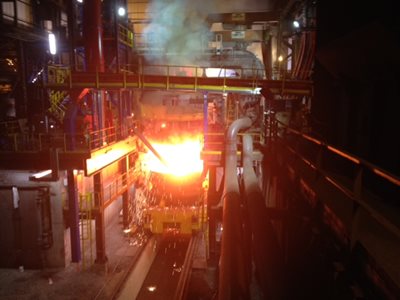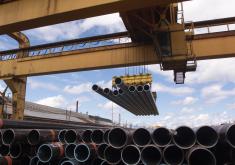Energy Independence Requires Steel Independence
Shale oil and gas, now fracked from deep underground in two dozen states, is celebrated for delivering energy independence to the United States. But that goal can’t truly be achieved if America depends on China, Korea, even Brazil for the steel vital to drilling.
Sustaining steel independence is a big part of what President Trump’s tariffs are about. They’re intended to revive American steel production which has been hammered by illegal trade practices, particularly in China. Just this week, the tariffs helped secure a new trade deal with Korea that reduces by 30 percent the amount of steel and drilling pipe the Asian country can export to the United States.
As fracking geared up across the United States, American steel makers invested in their mills to meet drillers’ needs, from pipe called Oil Country Tubular Goods (OCTG) to plate for platforms.
It was a symbiotic relationship. The new access to energy resources reduced the price of natural gas used in forging steel. That, of course, helped lower the price of American-made OCTG, plate and other steel essential for drilling.
In 2011, U.S. Steel invested more than $100 million to expand its Lorain, Ohio, mill to produce OCTG, creating 80 jobs and securing another 508. At the same time, Republic Steel spent $85 million at its Lorain mill, creating 450 jobs. This also was in response to the rush of drilling in the nearby Ohio, West Virginia and Pennsylvania Marcellus shale fields.
Lorain was booming. In 2014, the tax revenues it received from Republic Steel exceeded expectations by $800,000. That year, unemployment dropped to 5.2 percent, below the national rate of 5.8 percent.
But then, very quickly, it all fell apart. It was because of a combination of factors. Low prices for oil and gas deflated the drilling boom, reducing demand for steel. And unrealistically low prices for steel generally and underpriced drilling pipe from South Korea specifically made U.S. Steel and Republic Steel in Lorain uncompetitive.
Over the next two years, the two steelmakers’ Lorain facilities would struggle. Republic idled its mill that stands shoulder-to-shoulder with the U.S. Steel plant along the Black River. Republic laid off workers in groups of 50 and 200 until the mill that had employed 1,200 in 2015 went quiet in 2016. U.S. Steel announced in 2015 that it would idle its Lorain plant and furlough 614 workers there. But it managed to keep the doors barely open, with 220 workers on the job.
The town of Lorain was devastated. By August of 2016, the town had a revenue deficit of $3.6 million and a projected deficit for the following year of $2.1 million. It laid off 22 firefighters, then called them back only after receiving a one-time grant from the federal government to cover their wages for two years. The police department was squeezed. Capital projects were delayed. Lorain Mayor Chase Ritenauer would find himself bragging in his “state of the city” address earlier this year about how many vacant houses the town razed with state funds and lamenting, “The days of the 1,000-person factory, those days are not here anymore.”
By February this year, when Mayor Ritenauer reported on the city’s fate, unemployment in Lorain had risen to 6.2 percent, considerably higher than the national rate of 4.1 percent.
In addition to the decline in drilling, Lorain and its steelworkers were struck down by two factors. One is China’s massive overproduction of state subsidized steel. With government grants of free land, underpriced raw materials and cut-rate electricity, China’s steel companies can charge prices that are below production costs. When steel is exported at those artificially-low prices, it’s called dumping, and that violates international trade law. As a result, the United States has penalized China by charging tariffs on its steel for years. China sells the cheap steel elsewhere anyway, and that depresses the price worldwide.
The other factor is South Korea’s use of Chinese steel. South Korea is the largest importer of that underpriced Chinese steel. And South Korea is the third largest exporter of steel to the United States. Much of that has arrived in the United States in the form of OCTG – the very pipe that U.S. Steel invested $100 million in Lorain to produce.
Meanwhile, South Korea is manufacturing this pipe only for export. It has no wells. It imports nearly all of its oil and is the world’s second largest importer of liquid natural gas.
That is why the deal negotiated by the Trump administration to reduce South Korean exports of steel to the United States is so important. South Korea is using subsidized Chinese steel – that is steel sold in violation of international trade regulations – to produce pipe that directly competes with that made by U.S. pipe makers who abide by fair market rules.
South Korea agreed this week to export limits in exchange for an exemption from the new 25 percent tariffs the Trump administration has imposed on all steel imports.
South Korea’s OCTG exports to the United States contributed to the 70 percent increase in the trade deficit the United States has run with the Asian country since the two signed KORUS trade deal in 2012.
The minute President Trump imposed steel and aluminum tariffs early in March, free traders began screaming that the sky was falling. Dan Ikenson, of the libertarian CATO institute, is among the hysterics, telling the New York Times that trade deficits, like the ones the United States has with China and South Korea, don’t matter.
That’s because he is employed as a wonk at a Washington, D.C., institute funded by billionaires and doesn’t depend for his daily bread on work in a mill or on fair trade enforcement to enable that mill to operate profitably.
It doesn’t matter to him if the United States buys subsidized steel from China, forcing both mills in Lorain to fail and sink into the Black River.
He condemned President Trump’s trade policies as economic fantasy.
But back in Lorain, the economic reality is that Republic announced shortly after Trump imposed the new 25 percent steel tariffs that the company may begin rehiring 1,000 steelworkers as early as next month. City Councilman Angel Arroyo said, “This right now is the best news our city has gotten in a long time.”
It looks like Mayor Ritenauer was wrong about the demise of the 1,000-person factory.
Maybe now that Korea has agreed to cut its exports to the United States, U.S. Steel can resume making OCTG in Lorain too, and the United States can step toward renewed steel independence.
***
Republic Steel Lorain furnace photo courtesy of Association for Iron and Steel Technology.
Pipes at U.S. Steel Tubular Products, Lorain, Ohio.


